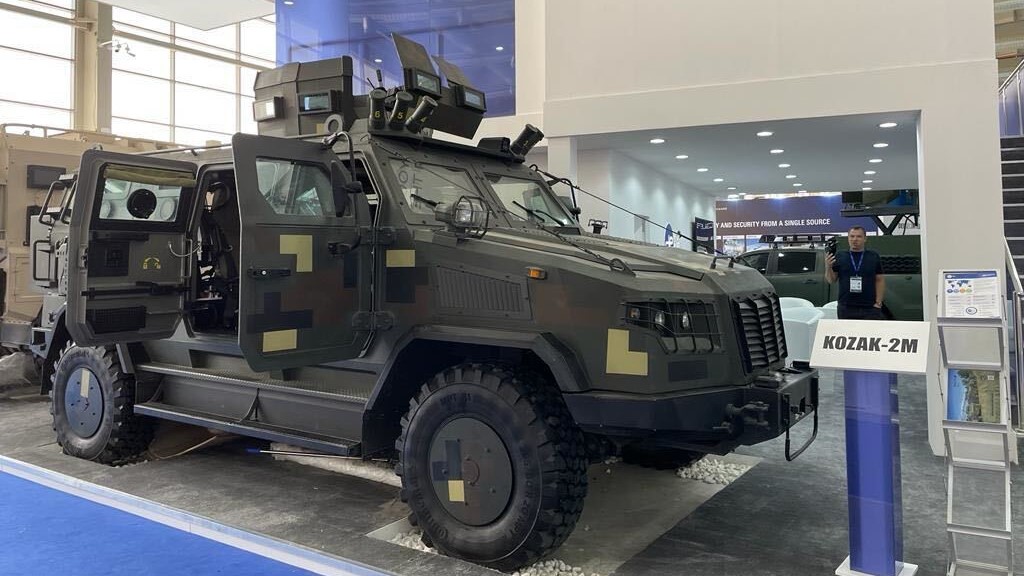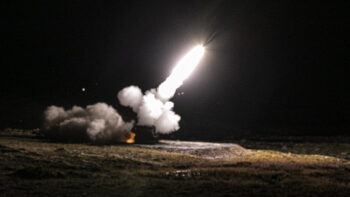
A Ukranian-made Kozak-2M on display at the World Defense Show in 2022. (Riad Kahwaji/Staff)
WORLD DEFENSE SHOW: Of the 600 exhibitors that took part in this week’s World Defense Show (WDS) in the Saudi capital of Riyadh, one truly stood out: the Ukrainian company Practika, which featured three armored vehicles on display, including one that was recently caught on camera in a showdown with a Russian tracked vehicle north of Kyiv.
“We build Kozak 2M which happens to be now the best of what we have in Ukraine in terms of an APC or armored fighting vehicle,” Oleg Biriutskyi, Practika’s international sales director, told Breaking Defense. Biriutskyi said he and another colleague arrived in Riyadh to prepare the company’s stand at WDS just a few days before an estimated 190,000 Russian troops launched an invasion of Ukraine.
He then showed with pride a video circulated on social media showing the Kozak 2M confronting a Russian Sosna tracked air defense platform. In the video, the two vehicles are headed for a confrontation before the Kozak opens fire with its heavy gun, sending the Russian vehicle speeding away.
Biriutskyi said he and another colleague arrived in Riyadh to prepare the company’s stand at WDS just a few days before an estimated 190,000 Russian troops launched an invasion of Ukraine.
Biriutskyi and his colleague appeared overwhelmed with the number of curious visitors who were surprised to see Ukrainian vehicles on display at this time. Both were also very concerned about their relatives and friends back home, who live in the vicinity of Kyiv.
Ukrainian Kozak-2M engaging Russian MT-LB in #Obolon, Kyiv. Video from yesterday pic.twitter.com/pPPCbmFacn
— MilitaryLand.net (@Militarylandnet) February 26, 2022
Practika’s story in a way mirrors that of Ukraine, a peaceful country that became more militarized because of Russian aggression over the past years.
“The company used to manufacture trucks for cash in transit vehicles. It built only civilian vehicles. But in 2014 after the Russians invaded Crimea and parts of eastern Ukraine, it decided to switch to manufacturing military vehicles to provide better armor protection to Ukrainian troops,” Biriutskyi said.
He pointed out that even though Ukraine was the main base of the Soviet armor industry, the quality of armor manufacturing is now totally different and largely superior to that of the Russians.
“Ukrainian industry has advanced, and unlike the Russians, it allocates more importance to the safety and comfort of the troops inside the vehicle. Ukraine has received a new and more advanced armor steel from Europe, which is much better quality than Russian armor that is easy to penetrate,” Biriutskyi added. “The quality of the welding of the steel plates in an overlapping way and the efficient quality control testing after completion have made our vehicles very secure and resistant to mines and explosions.”
Business for the company has been really good, according to Biriutskyi. “We managed to export a lot of our APCs and armored vehicles to many countries, including the Middle East region.”
What the future holds for the company, like everything in Ukraine, is clouded by what happens in the coming weeks of the conflict with Russia. He noted that the company’s factories are “somewhere near Kyiv in an area that we cannot disclose now because of the war.”
“Now after many of the company’s workers were called into reserve, the remaining employees will provide mechanical support to the Ukrainian military vehicles,” Biriutskyi said. “Our resources for now will focus on providing fix and repair work to the Ukrainian military vehicles to keep them operational in the fight.”
He added that “the vehicles we have here on display are going back straight to the Ukrainian troops in the battlefield.”
Biriutskyi showed a picture on his cell phone of his family huddling in a bomb basement near Kyiv and said that he was eager to return to Ukraine to answer the call of duty to defend his country.






















